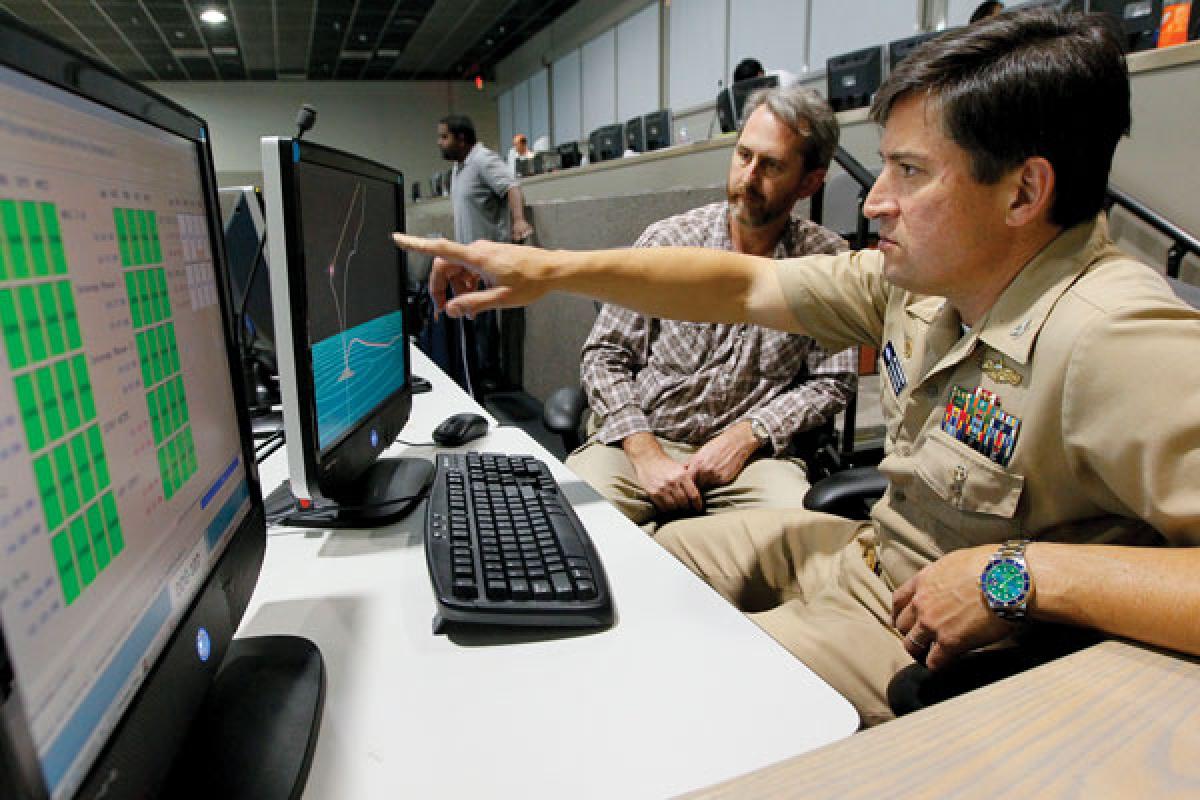The surface Navy and Lockheed Martin’s MS2 business unit, longtime prime contractor for the Aegis combat system on board Ticonderoga-class cruisers and Arleigh Burke–class destroyers,
will start next year to field an advanced Aegis program, designated Advanced Capability Build 12 (ACB-12). Meanwhile, Lockheed Martin, Northrop Grumman, and Raytheon are awaiting the start of a competition for a new air-missile-defense radar (AMDR) planned for the Flight III Burke program, which now is expected to start with DDG-121 or DDG-122.
The ACB-12 consolidates long-range/high-altitude ballistic-missile defense (BMD), the SQQ-89(v) integrated undersea-warfare system, and the Raytheon-developed RIM-174 SM-6 extended-range active air-defense missile.
The newest ACB also accommodates Raytheon’s cooperative-engagement capability (CEC), which enables multiple CEC-equipped ships and surveillance aircraft to conduct networked air defense by means of a common radar picture; the naval integrated fire-control counter-air system; and a multi-mission signal processor developed by Lockheed Martin based on commercially developed components and software, that integrates both air defense and BMD signal-processing functions.
The older Ticos, the so-called “baseline 2” ships, CG-52 through -58, now are getting ACB-08; installations are complete on board the Bunker Hill, Mobile Bay, and Philippine Sea (CG-52, -53, and -58).
ACB-12 then will go aboard the remaining four Ticonderogas, CG-59 through -73. The William S. Sims (DDG-113), now under contract to Huntington Ingalls Industries (formerly Northrop Grumman Shipbuilding, but spun off as a new company as of 31 March), will be the first new-construction Burke to get the program.
The ACB-12 also is set for integration with Aegis Ashore under the Missile Defense Agency’s “phased adaptive approach” to ballistic-missile defense. An Aegis Ashore site, consisting of Aegis BMD and the SM-3 ballistic-defense missile, will be established in Romania in 2015, with a second site in Poland in 2018.
Jim Sheridan, Lockheed Martin’s director of Aegis programs, said that following the John Paul Jones (DDG-53) and Sims, ACB-12 installations will continue on the Burkes for four or five years at a pace of about three per year. Ships that don’t get ACB-12 during that time frame would receive a follow-on ACB.
Because new ACBs are expected to be introduced every two years, the next iteration would be designated ACB-14, followed by ACB-16. Those new programs likely would be considerably less comprehensive than ACB-12, which Sheridan called the “largest development in the history of Aegis.”
Those new incremental advances, he said, could include full integration of the MH-60R helicopter, improvements to the ship gun-weapon system, underwater-warfare system, or a new shipboard electronic-warfare suite, now under development in a block-upgrade initiative called the Surface Electronic-Warfare Improvement Program.
Sheridan pointed out that the Navy is considering returning to a previous practice of designating combat systems as baselines—as with Baseline 7 Phase 1, the first iteration of the Aegis combat system to transition fully to commercial off-the-shelf software from Navy-unique software that was tightly bound to a proprietary computer architecture. Full compliance with the Navy’s open-architecture initiative in recent years has permitted a high degree of flexibility in introducing new processing and weapon-system capabilities in shorter time frames.
The critical next-generation step for ship combat systems, Sheridan said, is development of a high-power, solid-state AMDR for the Flight III Burkes. Lockheed Martin MS2, Northrop Grumman Electronic Systems, and Raytheon Integrated Defense Systems were awarded Navy contracts in June 2009 for development of AMDR S-band and radar-suite-controller technology, with work planned for completion in September 2012.
The AMDR is expected to incorporate X-band radar for precision tracking, missile communications, and terminal-target illumination, and an S-band radar for horizontal search, tracking, and BMD discrimination; these combine target detection and wide-area volume search, a concept initially pursued for the three-ship Zumwalt destroyer class, but later substantially modified. The Navy probably will start competitions for contract awards for the AMDR development and for integration of the Flight III combat system in the “not-too-distant future,” according to industry officials.




